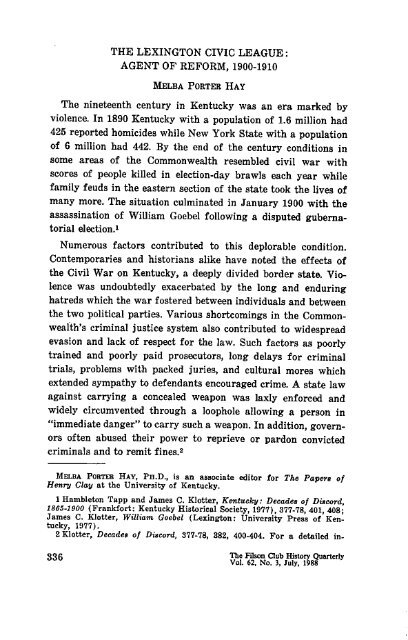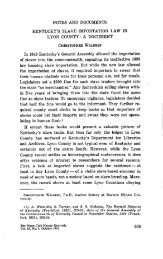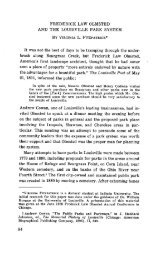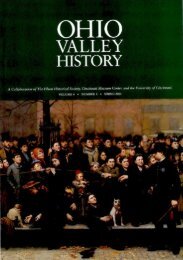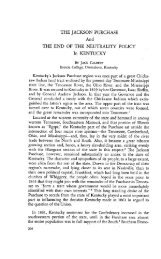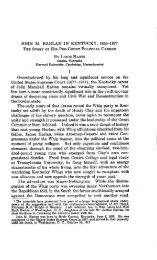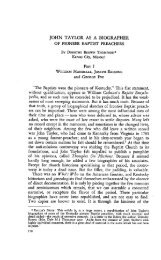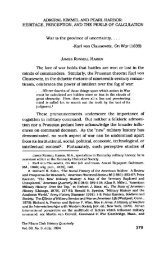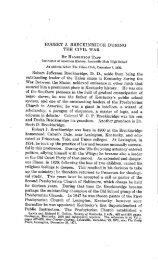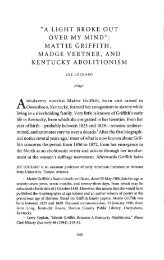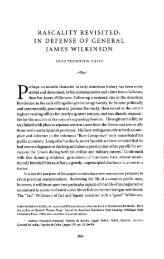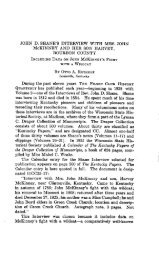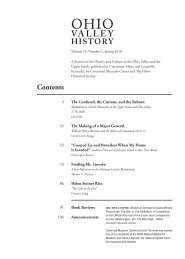The Lexington Civic League: Agent of Reform, 1900 - The Filson ...
The Lexington Civic League: Agent of Reform, 1900 - The Filson ...
The Lexington Civic League: Agent of Reform, 1900 - The Filson ...
Create successful ePaper yourself
Turn your PDF publications into a flip-book with our unique Google optimized e-Paper software.
THE LEXINGTON CIVIC LEAGUE :<br />
AGENT OF REFORM, <strong>1900</strong>-1910<br />
MELBA PORTER HAY<br />
<strong>The</strong> nineteenth century in Kentucky was an era marked by<br />
violence. In 1890 Kentucky with a population <strong>of</strong> 1.6 million had<br />
425 reported homicides while New York State with a population<br />
<strong>of</strong> 6 million had 442. By the end <strong>of</strong> the century conditions in<br />
some areas <strong>of</strong> the Commonwealth resembled civil war with<br />
scores <strong>of</strong> people killed in election-day brawls each year while<br />
family feuds in the eastern section <strong>of</strong> the state took the lives <strong>of</strong><br />
many more. <strong>The</strong> situation culminated in January <strong>1900</strong> with the<br />
assassination <strong>of</strong> William Goebel following a disputed gubernatorial<br />
election.l<br />
Numerous factors contributed to this deplorable condition.<br />
Contemporaries and historians alike have noted the effects <strong>of</strong><br />
the Civil War on Kentucky, a deeply divided border state. Violence<br />
was undoubtedly exacerbated by the long and enduring<br />
hatreds which the war fostered between individuals and between<br />
the two political parties. Various shortcomings in the Commonwealth's<br />
criminal justice system also contributed to widespread<br />
evasion and lack <strong>of</strong> respect for the law. Such factors as poorly<br />
trained and poorly paid prosecutors, long delays for criminal<br />
trials, problems with packed juries, and cultural mores which<br />
extended sympathy to defendants encouraged crime. A state law<br />
against carrying a concealed weapon was laxly enforced and<br />
widely circumvented through a loophole allowing a person in<br />
"immediate danger" to carry such a weapon. In addition, governors<br />
<strong>of</strong>ten abused their power to reprieve or pardon convicted<br />
criminals and to remit fines. 2<br />
ME LBA PORTER HAY, PH.D., is an associate editor for <strong>The</strong> Papers <strong>of</strong><br />
Henry Clay at the University <strong>of</strong> Kentucky.<br />
1 Hambleton Tapp and James C. Klotter, Kentucky: Decades <strong>of</strong> Discord,<br />
1865-<strong>1900</strong> (Frankfort: Kentucky Historical Society, 1977), 37%78, 401, 408;<br />
James C. Klotter, William Goebel (<strong>Lexington</strong>: University Press <strong>of</strong> Kentucky,<br />
1977).<br />
2 Klotter, Decades <strong>of</strong> Discord, 377-78, 382, 400-404. For a detailed in-<br />
336 <strong>The</strong> <strong>Filson</strong> Club History Quarterly<br />
Vol. 62, No. 3, July, 1988
1988] <strong>Lexington</strong> <strong>Civic</strong> <strong>League</strong> 337<br />
Even <strong>Lexington</strong>, a town <strong>of</strong> 26,369 people in <strong>1900</strong> and located<br />
in the heart <strong>of</strong> the supposedly genteel Bluegrass, was no stranger<br />
to violent crime or to lax law enforcement. By the turn <strong>of</strong> the<br />
century, however, reform elements were beginning to demand a<br />
safer and more progressive city. <strong>The</strong> reformers were galvanized<br />
into action by an incident which occurred on 11 February 1899,<br />
when John S. "King" McNamara shot Jacob Keller, a railroad<br />
cashier, on Main Street. Each man said he was jostled in the<br />
street by the other. Keller, who was known as a pleasant, peaceful<br />
man, died two days later. At the time <strong>of</strong> the shooting McNa-<br />
mara was arrested and released on a $1,000 bond which proved<br />
to be invalid because <strong>of</strong> an irregularity in the signature. Brought<br />
before a magistrate where he claimed self-defense, McNamara<br />
was again released on a $1,000 bond. When he failed to appear<br />
at the time set for his examining trial, local <strong>of</strong>ficials made little<br />
effort to apprehend him.s<br />
Many in the community were incensed by this breach <strong>of</strong> jus-<br />
tice. On 18 February a group <strong>of</strong> reform-minded women, repre-<br />
senting such organizations as the <strong>Lexington</strong> Woman's Club and<br />
the Women's Christian Temperance Union, joined together in<br />
calling a mass meeting to raise money to hire detectives to search<br />
for McNamara and to provide a reward for his capture. A <strong>Lexington</strong><br />
Herald editorial noted that since the law <strong>of</strong>ficers had<br />
failed in their job, <strong>Lexington</strong> would now be protected by the<br />
women. <strong>The</strong> public meeting, attended by both men and women,<br />
exerted enough influence to cause <strong>of</strong>ficials to convene a special<br />
terpretation <strong>of</strong> the failure <strong>of</strong> Kentucky's criminal justice system and its<br />
effect on crime in the Commonwealth, see Robert M. Ireland's articles, "Law<br />
and Disorder in Nineteenth Century Kentucky," Vanderbilt Law Review<br />
32 (1979): 281-99 and "Homicide in Nineteenth Century Kentucky," <strong>The</strong><br />
Register <strong>of</strong> the Kentucky Historical Society 81 (1983) : 134-53.<br />
3 John D. Wright, Jr., <strong>Lexington</strong>, Heart <strong>of</strong> the Bluegrass (<strong>Lexington</strong>:<br />
<strong>Lexington</strong>-Fayette County Historic Commission, 1982), 129; Abstract e!<br />
the Twelfth Census <strong>of</strong> the United States (Washington: U.S. Census Office,<br />
1901), Part 1, 131; Sophonisba P. Breckinridge, Madelin6 McDowell<br />
Breckinridge: A Leader in he New South (Chicago: University <strong>of</strong> Chicago<br />
Press, 1921), 33-35; <strong>Lexington</strong> H rald, 12, 13, 15 February 1899.
338: <strong>The</strong> <strong>Filson</strong> Club History Quarterly [July<br />
grand jury which indicted King McNamara's brother, William<br />
J. "Squire" McNamara, for shooting a police <strong>of</strong>ficer just two<br />
days after King had shot Keller. When the grand jury also called<br />
for the bond on which King McNamara had been released,<br />
Justice <strong>of</strong> the Peace Abner Oldham could not produce it. He and<br />
Police Judge John J. Riley were indicted for malfeasance in<br />
<strong>of</strong>fice for their handling <strong>of</strong> the McNamara cases. <strong>The</strong> indictments<br />
against Oldham and Riley were later dismissed but<br />
Squire McNamara was convicted and received a three-year prison<br />
sentence.4<br />
<strong>The</strong> mass meeting did not result in the immediate capture <strong>of</strong><br />
King McNamara) It did, however, lead directly to the formation<br />
<strong>of</strong> a permanent organization to promote civic improvements. On<br />
17 April <strong>1900</strong>, the <strong>Lexington</strong> <strong>Civic</strong> <strong>League</strong> was founded by much<br />
the same group that had organized the mass meeting the previous<br />
year. Ida W. Harrison, president <strong>of</strong> the <strong>Lexington</strong> Woman's<br />
Club, presided over the initial meeting. At the next meeting<br />
on 10 May, Judge Samuel M. Wilson, a socially prominent attorney,<br />
judge, and pr<strong>of</strong>essor <strong>of</strong> law, was elected president while<br />
Edward M. Wiley and Mary McClellan, both local physicians,<br />
were chosen vice president and secretary. Two <strong>of</strong> the most influential<br />
charter members were Desha Breckinridge and his<br />
wife, Madeline McDowell Breckinridge. Breckinrldge was the<br />
managing editor <strong>of</strong> the <strong>Lexington</strong> Herald, which was owned by<br />
his father, former congressman W. C. P. Breckinridge. During<br />
4 <strong>Lexington</strong> Herald, 16, 17, 18, 19, 22, 23, 24, 25, 26 February, 8, 9, 31<br />
March, 1 April 1899; "Resolutions <strong>of</strong> the Mass Meeting <strong>of</strong> February 21,<br />
1899" Breckinridge Family Papers, Library <strong>of</strong> Congress, Washington D.C.<br />
<strong>The</strong> Breckinridge Papers have now been organized and a guide to them<br />
has been prepared, but this was not the case when I surveyed them. Thus<br />
no references to box numbers or titles will be given since they would not<br />
be meaningful.<br />
5 King McNamara remained a fugitive tmtil 14 June 1912, when he was<br />
arrested by Fayette County Sheriff Daniel W. Scott at the Seelbach Hotel<br />
in Louisville. On 12 July the jury rendered a verdict <strong>of</strong> voluntary :man-.<br />
slaughter, and he was sentenced to five years at labor. King's brother<br />
Squire had been killed in a saloon shooting in <strong>Lexington</strong> soon after his<br />
release from prison in 1901. <strong>Lexington</strong> Herald, 17 September 1901, 15, 16<br />
June, 2, 6, 13, 14, 23 July 1912.
1988] <strong>Lexington</strong> <strong>Civic</strong> <strong>League</strong> 339<br />
the first two decades <strong>of</strong> the twentieth century this newspaper<br />
became a major force in promoting the progressive reform movement.<br />
Both its news reporting, which gave the <strong>Civic</strong> <strong>League</strong> and<br />
other reform groups front-page coverage, and its editorial<br />
stance wei e greatly influenced by Mrs. Breckinridge. <strong>The</strong> greatgranddaughter<br />
<strong>of</strong> Henry Clay and the great-niece <strong>of</strong> Dr. Ephraim<br />
McDowell, she became known throughout the state as a leader<br />
fo1: progressive reforms and for woman suffrage. Indeed, evidence<br />
in her papers indicates that she was the one who formulated<br />
the idea <strong>of</strong> establishing a civic league in <strong>Lexington</strong>)<br />
• Immediately after its creation the <strong>Civic</strong> <strong>League</strong> began to promote<br />
reforms similar to those being advocated by Progressives<br />
around the country.7 Very <strong>of</strong>ten these reformers focused on the<br />
child as the key to solving existing social problems; this was<br />
true<strong>of</strong> the <strong>Lexington</strong> <strong>Civic</strong> <strong>League</strong>. While it might be too late to<br />
liber .te adults from the cycle <strong>of</strong> poverty, disease, and exploitation,<br />
they hoped to prevent the child from following the same<br />
path. As a 1902 <strong>Lexington</strong> Herald editorial expressed it: "Fellow<br />
6 Ida (Mrs. Albert M.) Harrison had been one <strong>of</strong> the founders <strong>of</strong> the<br />
Kentucky Federation <strong>of</strong> Women!s Clubs. See Mrs. W. T. Lafferty, comp.,<br />
Fifty Years <strong>of</strong> Service Outline History, Kentucky Federation <strong>of</strong> Women's<br />
Clubs (n.p.: Kentucky Federation <strong>of</strong> Women's Clubs, 1944), 14. For<br />
Samuel M. Wilson, see Charles Kerr, ed., History <strong>of</strong> Kentucky (5 vols.;<br />
Chicago: American Historical Association, 1922), 3:365. Detailed accounts<br />
<strong>of</strong> the role <strong>of</strong> Desha and Maleline Breckinridge in the Progressive reform<br />
movement in <strong>Lexington</strong> are found in James C. Klotter's, "<strong>The</strong> Breckinridges<br />
<strong>of</strong> Kentucky, Two Centuries <strong>of</strong> Leadership" (Ph.D. dissertation, University<br />
<strong>of</strong> Kentucky, 1975), 226-35 and his book, <strong>The</strong> Brecklnridges <strong>of</strong> Kentucky,<br />
1760-1981 (<strong>Lexington</strong>: University Press <strong>of</strong> Kentucky, 1986), 208-<br />
243; also Melba Porter Hay, "Madeline McDowell Breckinridge: Kentucky<br />
Suffragist and Progressive <strong>Reform</strong>er" (Ph.D. dissertation, University <strong>of</strong><br />
Kentucky, 1980). <strong>The</strong> resolutions adopted at the mass meeting <strong>of</strong> 21 February<br />
1899 (see note 4 above) were handwritten by Mrs. Breckinridge.<br />
7 For various interpretations <strong>of</strong> Progressivism and its goals, see John D.<br />
Buenke ': Urban Liberalism and Progressive <strong>Reform</strong> (New York: Charles<br />
Scribner's Sons, 1973) ; Allen F. Davis, Spearheads for <strong>Reform</strong>: <strong>The</strong> Social<br />
Settlements and the Progressive Movement, 1890-191d, (New York: Oxford<br />
University Press, 1967) ; Eric F. Goldman, Rendezvous With Destiny (New<br />
York: Alfred A. Knopf,Inc., 1952) ; Richard H<strong>of</strong>stadtor, <strong>The</strong> .4ge <strong>of</strong> <strong>Reform</strong><br />
(New York: Alfred A. Knopf, Inc., 1955); Jack Tager, "Progressives,<br />
Conservatives and the <strong>The</strong>ory <strong>of</strong> the Status Revolution, ''• M/d-<br />
America 48 (1966): 162-75 Robert H.'.Wiebol <strong>The</strong> Search for Order, 1877-<br />
19 0 (New York: Hilt and Wang, 1967).
340 <strong>The</strong> <strong>Filson</strong> Club History Quarterly [July<br />
Citizens, let us remember, if we are not satisfied with the present<br />
status <strong>of</strong> affairs, that our hope lies in the children <strong>of</strong> our<br />
State...." Thus the <strong>League</strong> became a prime force behind such<br />
causes as improving public education, developing parks and playgrounds,<br />
establishing a juvenile court system, and ending child<br />
labor,s<br />
In <strong>1900</strong> <strong>Lexington</strong> did not have a single public park nor did<br />
any <strong>of</strong> the schools have a playground. This became the first<br />
major goal <strong>of</strong> the <strong>Civic</strong> <strong>League</strong>. In its first year <strong>of</strong> existence the<br />
<strong>League</strong> concentrated its efforts on publicity in order to raise<br />
public consciousness <strong>of</strong> the need for such facilities. At the first<br />
meeting <strong>of</strong> 1901, Madge Breckinridge presented an <strong>of</strong>fer by Richard<br />
P. Stoll, president <strong>of</strong> the Commonwealth Distillery Company<br />
and owner <strong>of</strong> a wholesaler liquor dealership, to provide a lot on<br />
Manchester Street for one year to be used as a playground. <strong>The</strong><br />
<strong>Civic</strong> <strong>League</strong> accepted the <strong>of</strong>fer, appointed Mrs. Breckinridge<br />
and Mary McClellan to be the playground committee, and authorized<br />
them to seek the cooperation <strong>of</strong> the Woman's Club.S<br />
<strong>The</strong> site for the new playground was in the west end <strong>of</strong> the<br />
city, a section known as Irishtown. <strong>The</strong> poorest and most<br />
blighted area <strong>of</strong> <strong>Lexington</strong>, Irishtown had evolved in the 1840s<br />
when a large number <strong>of</strong> Irish descendants congregated in the<br />
area to work in factories and on the railroads. <strong>The</strong> streets were<br />
unpaved, there was no drainage, houses were crowded, and<br />
toilet facilities were inadequate. Sewage contaminated the water<br />
supply. Smoke and stench from the distillery poured over it.<br />
<strong>Civic</strong> <strong>League</strong> members, therefore, felt an urgent need to do<br />
something for the area, especially for the children living there.<br />
8 <strong>Lexington</strong> Herald, 18 April, 11 May <strong>1900</strong>, 24 June 1902, 31 January<br />
1903, 12 February 1911.<br />
9 A Review <strong>of</strong> <strong>Lexington</strong> As She Is (New York, 1887 [?]), 65; <strong>Lexington</strong><br />
Herald, 16, 18 June, 1 July 1901; interview, Florence Shelby Cantrill with<br />
author, 25 March, 25 October 1976. Years later, Mrs. Breeklnridge recalled<br />
the day when she had asked StoU for the use <strong>of</strong> the Manchester lot<br />
and remembered "the quick and generous response" be made. M. M. Breckinridge<br />
to Mrs. R. P. Stoll, 19 July 1916, Breckinridge Family Papers,<br />
Library <strong>of</strong> Congress.
1988] <strong>Lexington</strong> <strong>Civic</strong> <strong>League</strong> 841<br />
<strong>The</strong>y viewed the playground as a first step toward reforming<br />
the whole section,l°<br />
<strong>The</strong> Woman's Club gave $200.00 for the project; it required<br />
much exhausting work to prepare the Manchester Street lot.<br />
When the playground opened on 17 June, benches, flowers, and<br />
play equipment transformed the grounds. Kindergarten and<br />
sewing classes met each weekday, with Elizabeth Cloud, a<br />
trained teacher, serving as head <strong>of</strong> the kindergarten. For ten<br />
weeks the <strong>League</strong> maintained the playground at a total cost <strong>of</strong><br />
$275.00. Most importantly, the <strong>Civic</strong> <strong>League</strong> persuaded city <strong>of</strong>ficials<br />
to install a hydrant with filtered water from the reservoir<br />
which was made available to everyone in Irishtown, providing<br />
residents there with their first safe source <strong>of</strong> water.11<br />
A variety <strong>of</strong> other activities were held at the playground;<br />
some <strong>of</strong> which were open to the entire community. On one occasion<br />
nearly 150 Irishtown residents attended an open-air concert.<br />
Almost all <strong>of</strong> them expressed to the sponsors their pleasure<br />
at the effect the playground was producing on their children. A<br />
policeman from the area noted that in the evenings the children<br />
gathered to sing the songs they had learned during the day at<br />
the playground. 2<br />
When it closed at the end <strong>of</strong> the summer, Madge Breckinridge<br />
summed up her thoughts in an article, "<strong>The</strong> Passing <strong>of</strong> the<br />
Playground." She viewed the effort as a supplement to the public<br />
schools, noting that out <strong>of</strong> 124 children who had attended the<br />
playground, only twenty-seven had ever attended elementary<br />
school or kindergarten. Almost all the children were <strong>of</strong> school<br />
age and, reportedly, more planned to enroll in public school<br />
than ever before. Despite this encouraging sign, she pointed<br />
10 Davis, Spearhead8 for Refcrm, 60-65; Raymond G. Fuller, Recreation<br />
and Child Welfare (New York: National Child Labor Committee, 1919),<br />
3-11; <strong>Lexington</strong> Herald, 21 August 1977; Wright, <strong>Lexington</strong>, 139; Breckinridge,<br />
Madeline MeDowell Breckinridge, 48-50.<br />
ll<strong>Lexington</strong> Herald, 16, 18 June, 1 July, 4, 12 August 1901; Breckinridge,<br />
Madellne McDowell B 'eckln idge, 48-50.<br />
12 <strong>Lexington</strong> Herald, 4, 12 August 1901.
342 <strong>The</strong> <strong>Filson</strong> Club History Quarterly [July<br />
out, many Irishtown parents were reluctant to allow their young<br />
children to go to public school because they had to walk long<br />
distances and cross dangerous railroad tracks. This situation<br />
highlighted the need for building a kindergarten and elementary<br />
school in Irishtown. 13<br />
While on a trip in early 1902, Mrs. Breckinridge studied the<br />
playground system in San Francisco. On her return home, she<br />
informed the community <strong>of</strong> her findings as she continued to<br />
promote the cause in <strong>Lexington</strong>. She announced at a <strong>Civic</strong> <strong>League</strong><br />
meeting, held at her home, that the Manchester lot would not be<br />
available for the coming summer and that the Woman's Club<br />
would not pledge financial support as it had the previous year.<br />
<strong>The</strong> <strong>League</strong> ultimately decided to hold a vacation school and a<br />
playground for two months during the summer. <strong>The</strong> playground<br />
committee chose a house on Willard Street for the school and a<br />
lot on South Upper Street for the playground. <strong>The</strong>y hired a<br />
young woman who had taught in a social settlement in New<br />
York City to teach cooking, sewing, and housewifery, and employed<br />
Elizabeth Cloud as head <strong>of</strong> the vacation school. When the<br />
school opened in July, seventy-four children enrolled, fifty <strong>of</strong><br />
them in the kindergarten division. Mrs. Breckinridge also per-<br />
suaded the mayor to install a hydrant and a water fountain at<br />
the Willard Sireet location.14<br />
<strong>The</strong> Upper Street playground with basketball and tennis<br />
courts opened in late July. <strong>The</strong> Combs Lumber Company, owned<br />
by Thomas A. Combs, a friend <strong>of</strong> the Breckinridges and subsequently<br />
<strong>Lexington</strong> mayor and state senator, had moved the<br />
equipment used the previous year and had set it up on the lot<br />
without charge. Berkeley M. Fontaine <strong>of</strong> Hanover County, Virginia,<br />
became the playground supervisor. Baseball and basketball<br />
teams from the playground and the school competed against each<br />
other during the summer. All <strong>of</strong> these activities were supported<br />
13 Ibid., 8 September 1901.<br />
14 Ibid., 2, 5 March,. 29 April, 4 28, 29 May, 2. 8, 11, 13, 15, 22 July<br />
1902; W. C. P. Brecklnridge to Sophonisba P. Breckinridge, 28 Febi"uary,<br />
12 April 1902, Breckinridge Family Papers, Library <strong>of</strong> Congress.
1988] <strong>Lexington</strong> <strong>Civic</strong> <strong>League</strong> 343<br />
by private contributions <strong>of</strong> money and supplies solicited by the<br />
<strong>Civic</strong> <strong>League</strong>. 15<br />
A significant victory for Irishtown children resulted from<br />
these activities. On 7 August 1902, two representative <strong>of</strong> the<br />
<strong>Civic</strong> <strong>League</strong> -- Mrs. Breckinridge and Mrs. Shelby T. Harbison,<br />
wife <strong>of</strong> the owner <strong>of</strong> <strong>Lexington</strong> Tattersalls thoroughbred dealership<br />
-- attended a meeting <strong>of</strong> the board <strong>of</strong> education to plead for<br />
the establishment <strong>of</strong> a permanent, public kindergarten in Irishtown.<br />
<strong>The</strong> board agreed to maintain the kindergarten which the<br />
<strong>League</strong> had started there and to hire two teachers. From then<br />
on the kindergarten was in the hands <strong>of</strong> the school board. 16<br />
<strong>The</strong> movement for a city park system also made headway in<br />
1902. A Herald editorial suggested that Woodland Park -- a fifteen-acre<br />
site on High Street and Park Avenue then used by the<br />
Chautauqua Association for a variety <strong>of</strong> cultural, educational,<br />
and recreational programs -- be opened to the public during the<br />
summer months. This was accomplished after the Herald se-<br />
cured promises from the mayor and fire chief to provide pro-<br />
tection to the area. In addition, the <strong>Lexington</strong> Railway Company,<br />
which would pr<strong>of</strong>it from fares to and from the park, agreed to<br />
provide lights, entertainment, and upkeep for the grounds. Dean<br />
P. Baker Lee <strong>of</strong> Christ Church Episcopal in a sermon urged the<br />
city to purchase Woodland Park and open it to the public permanently.<br />
<strong>The</strong> Herald endorsed the idea immediately, and the<br />
city completed the purchase in 1903. At the instigation <strong>of</strong> the<br />
<strong>Civic</strong> <strong>League</strong>, <strong>Lexington</strong> <strong>of</strong>ficials hired one <strong>of</strong> the country's outstanding<br />
landscape architectural firms, the Olmsted Brothers <strong>of</strong><br />
Massachusetts, to develop it. This marked the first step in the<br />
development <strong>of</strong> a city park system which would within twenty<br />
years encompass five public parks and playgrounds, two vacant<br />
play areas, and three playgrounds at children's institutions, with<br />
15 <strong>Lexington</strong> Herald, 20, 24 July, 14, 20 August 1902. For Thomas<br />
Combs, see Kerr, History o/ Kentucky, 4:199.<br />
16 <strong>Lexington</strong> Herald, 8 August, 5 December 1902; Breckinridge, Madeline<br />
McDowell Breekinridge, 51. For Shelby T. Harbison, see Kerr, History <strong>of</strong><br />
Kentucky, 3:193.
344 <strong>The</strong> <strong>Filson</strong> Club History Quarterly [July<br />
twelve supervisors hired by the city. <strong>The</strong> <strong>League</strong> remained active<br />
in directing these parks and playgrounds with help from the<br />
city until 1927 when they were made a department <strong>of</strong> the municipal<br />
government.l<br />
Members <strong>of</strong> the <strong>Civic</strong> <strong>League</strong> also recognized the need for<br />
various kinds <strong>of</strong> improvements in the field <strong>of</strong> education. Mrs.<br />
Breckinridge spoke to the school board in December 1902 asking<br />
that manual or vocational training be initiated in all the public<br />
schools. <strong>The</strong> board responded by appointing a committee to<br />
study the possibility. Encouraged by this action, the <strong>League</strong><br />
dramatized its interest in education by bringing to <strong>Lexington</strong><br />
Jane Addams, the famed Hull House reformer, to speak on<br />
"New Ideals in Education." In a speech, given on the campus <strong>of</strong><br />
Kentucky University (now Transylvania University), on 14<br />
May 1903, she called for an end to child labor, for the introduction<br />
<strong>of</strong> manual training in the schools, and for playgrounds and<br />
kindergartens.lS<br />
Publicity for manual training continued as the <strong>League</strong> brought<br />
Judge Ben B. Lindsey <strong>of</strong> Denver, Colorado, a pioneer in the<br />
development <strong>of</strong> the juvenile court system, to <strong>Lexington</strong> in 1905.<br />
In an address at the Opera House on 30 January and at the<br />
Courthouse on the following day, Lindsey spoke on "Manual<br />
Training as a Preventive <strong>of</strong> Delinquency in Children," arguing<br />
for the benefits <strong>of</strong> both manual training and a juvenile court<br />
system. One reason why children got into trouble, he said, was<br />
because they could not find employment. Manual training schools,<br />
he contended, were "moral hospitals" which would train children<br />
for a job and thereby keep them out <strong>of</strong> trouble.1<br />
17 Wright, <strong>Lexington</strong>, 10O; <strong>Lexington</strong> Herald, 11, 13 July, 8 September<br />
1902, 30 January, 31 May, 1 April, 2, 14, 30 June, 30 August 1903, 27 April,<br />
1O, 26 June, 31 August, 5 September, 20 November 1904; Florence Shelby<br />
Cantrill, "Among My Souvenirs," unpublished autobiography in possession<br />
<strong>of</strong> Mrs. Florence Tabling, <strong>Lexington</strong>, 90. For a brief history <strong>of</strong> the<br />
traveling Chautauqua groups which provided lectures, concerts, and recitals<br />
around the country, see World Book Encyclopedia (Chicago: World<br />
Book, 1984), 3:301.<br />
18 <strong>Lexington</strong> Herald, 30 June, 4 July, 5 December 1902, 12, 13, 14 May<br />
1903. -<br />
19 Ibid., 31 January, 1 February 1905; "Reports <strong>of</strong> Hon. Ben B. Lindsey,
1988] <strong>Lexington</strong> <strong>Civic</strong> <strong>League</strong> 345<br />
By the autumn <strong>of</strong> 1905 the school board indicated it would<br />
consider including some form <strong>of</strong> manual training in its January<br />
budget. During the fall the <strong>Civic</strong> <strong>League</strong> continued to sponsor<br />
lectures on the subject by such experts as Pr<strong>of</strong>essor Harry G.<br />
Brownell <strong>of</strong> Flexner University School in Louisville and Chicago<br />
social workers and reformers, Marion Talbott and Dr. Sophon-<br />
isba P. Breckinridge. (<strong>The</strong> latter, a sister <strong>of</strong> Desha Breckinridge,<br />
was a pr<strong>of</strong>essor at the University <strong>of</strong> Chicago and a pioneer in<br />
the pr<strong>of</strong>essionalization <strong>of</strong> social work.) Superintendent M. "A.<br />
Cassidy pr<strong>of</strong>essed to be a convert to the cause, but when the<br />
school board met in January 1906, it again decided that Lexing-<br />
ton could not afford to institute manual training. <strong>The</strong> next yea1:,<br />
however, after the <strong>League</strong> <strong>of</strong>fered to help finance the initial<br />
expenses <strong>of</strong> the program, the school board appropriated $4000 to<br />
begin manual training in carpentry and domestic science.2°<br />
At the 1906 session <strong>of</strong> the Kentucky General Assembly, the<br />
<strong>Civic</strong> <strong>League</strong> helped to sponsor a juvenile court bill. Drafted by<br />
Bernard Flexner and Albert Brandeis <strong>of</strong> Louisville, the bill was<br />
introduced in the house on 20 January. It provided for juvenile<br />
courts in first and second-class cities with the county judge as<br />
the presiding magistrate, assisted by a probation <strong>of</strong>ficer and one<br />
other appointee. In an effort to promote the cause, the <strong>Civic</strong><br />
<strong>League</strong> sponsored a return visit by Judge Lindsey. On 2 March,<br />
the day he spoke in <strong>Lexington</strong>, the house passed the bill, and on<br />
21 March the senate did also. Upon his return home Lindsey<br />
Chairman, Committee on Juvenile Courts," Breckinridge Family Papers,<br />
Library <strong>of</strong> Congress; Ben B. Lindsey to Madeline MeDowell Breckinridge,<br />
7 August 1905, Ben B. Lindsey Papers, Library <strong>of</strong> Congress.<br />
20 <strong>Lexington</strong> Herald, 10 September, 24, 27, 29 December 1905, 1, 4<br />
January, 12 February, 5 May, 3 October 1907. Sophonisba Breckinridge's<br />
importance in developing an educational curriculum and philosophy leading<br />
to the pr<strong>of</strong>essionalization <strong>of</strong> social work, as well as her close relationship<br />
to Chicago social settlement workers and other Progressives, is amply detailed<br />
in Lela B. Costin, Two Sistvrs /or Social Justice, A Biography o/<br />
Grave and Edith Abbott (Chicago: University <strong>of</strong> Illinois Press, 1983), 27,<br />
58-67, 119, 184, 194, 227-28 and also in Klottsr, B 'eckln 'idges o/Kvntueky,<br />
189-90, 201-207.
346 <strong>The</strong> <strong>Filson</strong> Club History. Quarterly [July<br />
wrote Mrs. Breckinridge: "<strong>The</strong> women <strong>of</strong> the country are doing<br />
the work for the children, and it is such unselfish, devoted and<br />
magnificent work as yours... [which has] inspired me to speak<br />
the truth in this matter."21<br />
During these years the <strong>Civic</strong> <strong>League</strong> also concerned itself with<br />
ending child labor and providing for compulsory school atten-<br />
dance. In 1902 Kentucky had passed a child labor law which prohibited<br />
the employment <strong>of</strong> children under fourteen in workshops,<br />
mines, mills, or factories except with the written approval <strong>of</strong><br />
the parent or guardian and the agreement <strong>of</strong> the county attorney.<br />
This exception proved to be a loophole <strong>of</strong> significant magnitude<br />
which the <strong>Civic</strong> <strong>League</strong> hoped to circumvent by a more stringent<br />
compulsory school attendance law. <strong>The</strong>y lobbied for and helped<br />
obtain passage in 1904 <strong>of</strong> a law which lengthened the school<br />
term to six months and compelled children aged seven to fourteen<br />
in cities <strong>of</strong> first through fourth classes to attend school for<br />
the full term. At the 1906 legislative session the <strong>Civic</strong> <strong>League</strong><br />
also supported a bill creating two state normal schools for the<br />
purpose <strong>of</strong> educating teachers.<br />
More sweeping changes than these, however, were needed to<br />
deal with the deplorable educational condition <strong>of</strong> the state. <strong>The</strong><br />
<strong>1900</strong> census had shown Kentucky to be thirty-seventh in literacy,<br />
while only eighty-one <strong>of</strong> (then) 119 counties had a pub!ic high<br />
school. In addition, state superintendents <strong>of</strong> public instruction<br />
for years had called for an end to the district system adminis-<br />
tered by more than 24,000 school trustees, many <strong>of</strong> whom did<br />
not want the <strong>of</strong>fice and refused to meet their responsibility. Fay-<br />
21 <strong>Lexington</strong> Herald, 4, 7, 9, 14 January, 2, 6 February, 18 March. 1907;<br />
Ben Lindsey to M. M. Breekinridge, 12 March 1906, Lindsey .Papers,<br />
Library <strong>of</strong> Congress; Edward Clopper, Child Wel[ars 17 Kentucky (New<br />
York, 1919), 203-204. A rather negative view <strong>of</strong> Judge Lindsey and the<br />
effects <strong>of</strong> the juvenile court system is presented in David A. Rothman,<br />
Censcisnce and Convenience, <strong>The</strong> Asylum and its Alternatives in Progressive<br />
America (Boston: Little, Brown and Company, 1980), 205-25.<br />
22 Kentucky General Assembly Acts . . . (1902), 44-45; Kentucky General<br />
Assembly Acts . . . (1906), 393-404; Barksdale Hamlett, History o/<br />
Education in Kentucky (Frankfort, 1914), 190.
1988] Lexin'gton <strong>Civic</strong> <strong>League</strong> 347<br />
ette County, for example, in 1907 had thirty white and fourteen<br />
black school districts.2a<br />
In 1907 the Kentucky Federation <strong>of</strong> Women's Clubs under-<br />
took a major campaign for educational reforms, calling for<br />
consolidated school districts, school suffrage for women, and<br />
an increased appropriation for the new state normal schools at<br />
Richmond and Bowling Green. <strong>The</strong> <strong>Civic</strong> <strong>League</strong> added its en-<br />
thusiastic support toward helping lay the groundwork for the<br />
so-called "Educational Legislature" <strong>of</strong> 1908. Responding to sta-<br />
tistics showing that fewer than fifty percent <strong>of</strong> school-age<br />
children were attending school and that approximately fifteen<br />
percent <strong>of</strong> the white, adult, male population was illiterate (in-<br />
cluding about 5,000 school trustees), the General Assembly<br />
passed a series <strong>of</strong> laws intended to remedy the situation. <strong>The</strong><br />
most significant <strong>of</strong> these acts was the Sullivan bill which estab-<br />
lish-ed the county as the school unit, required the counties to<br />
levy taxes to support local schools, and required the establish-<br />
ment <strong>of</strong> a high school in each county within two years. Other<br />
acts included an appropriation <strong>of</strong> $500,000 for the state colleges<br />
and normal schools, a law strengthening enforcement <strong>of</strong> com-<br />
pulsory school attendance, and another calling for creation <strong>of</strong><br />
a state educational commission to recommend future avenues<br />
for reform. 4<br />
23Mable P. Dagett, "Kentucky's Fight for an Education," in <strong>The</strong><br />
Delineator, John G. Crabbe Scrapbook, Townsend Room, Eastern Kentucky<br />
University Library; John Grant Crabbe, Biennial Report <strong>of</strong> the Superintendent<br />
<strong>of</strong> Public Instruction for the Two Years Ending June 30, 1909<br />
(Frankfort, 1909), 15, 21, 293.<br />
24 <strong>Lexington</strong> Herald, 17 March, 9 April, 22 June, 14, 28 July, 5 October,<br />
3, 21 November 1907; Nancy Forderhase, "'Limited Only By Earth and<br />
Sky': <strong>The</strong> Louisville Woman's Club and Progressive <strong>Reform</strong>," <strong>The</strong> <strong>Filson</strong><br />
Club History Quarterly 59 (1985): 337, 339; Forderhase, "'<strong>The</strong> Clear Call<br />
<strong>of</strong> Thoroughbred Women': <strong>The</strong> Kentucky Federation <strong>of</strong> Women's Clubs<br />
and the Crusade for Educational <strong>Reform</strong>, 1903-1909," <strong>The</strong> Register <strong>of</strong> the<br />
Kentucky Historical Society 83 (1985) : 25-31, passim; Hamlett, History <strong>of</strong><br />
Education in Kentucky, 200-210. For a further discussion <strong>of</strong> women and<br />
educational reforms in the South, see James L. Leloudis, II, "School <strong>Reform</strong><br />
in the New South: <strong>The</strong> Woman's Association for the Betterment <strong>of</strong><br />
Public School Houses in North Carolina, 1902-1919," Journal <strong>of</strong> American<br />
History 69 (1983) : 886-909.
348 <strong>The</strong> <strong>Filson</strong> Club History Quarterly [July<br />
<strong>The</strong> <strong>League</strong> also inaugurated in 1908 a major educational reform<br />
effort <strong>of</strong> its own, designed to provide a so-called "Model<br />
School" in the west end <strong>of</strong> the city. By this time the kinder-<br />
garten started in Irishtown in 1902 had grown into an elementary<br />
school with four grades. Conditions at the school were<br />
very poor with 150 pupils crowded into a three-room cottage.<br />
When the board <strong>of</strong> education appropriated $10,000 in 1908 to<br />
construct a larger building, the <strong>Civic</strong> <strong>League</strong>, under the guidance<br />
<strong>of</strong> Madeline McDowell Breckinridge, undertook to raise $35,000<br />
to provide the facilities necessary to make it a "Model School."<br />
It was to have a carpentry shop, a gymnasium, a laundry, shower<br />
baths, a swimming pool, and an assembly hall. In addition it<br />
would provide manual training in every grade and the public<br />
would be allowed to use its facilities. In short, it was to serve<br />
as a social and civic center for the community.25<br />
Mrs. Breckinridge, the current <strong>Civic</strong> <strong>League</strong> president, organized<br />
the fund-raising efforts for the school and contributed<br />
three lots, valued at $350.00 for the site <strong>of</strong> the school, plus<br />
$650.00 in cash. Her mother, Anne Clay McDowell, and her aunt,<br />
Magdalen McDowel], each contributed $1,000. In the spring <strong>of</strong><br />
1909 Mrs. Breckinridge traveled to Chicago in an effort to interest<br />
ex-Kentuckians and other Chicago philanthropists in the<br />
project. She received $1,000 from Robert Todd Lincoln, son <strong>of</strong><br />
Abraham Lincoln for whom the school was eventually named,<br />
and $100.00 in gold from Mrs. Ogden Armour, an old chum<br />
from Miss Porter's School in Farmington, Connecticut. <strong>The</strong>se<br />
and several smaller contributions made this trip very pr<strong>of</strong>itable.<br />
James R. Keene, a Bluegrass horseman who resided in New<br />
York City, donated $1,000. <strong>The</strong> <strong>League</strong> sponsored a lawn fete<br />
in May to raise money. It was held at "Ashland," the home <strong>of</strong><br />
Henry Clay which was then owned by Mrs. Brecklnridge's<br />
family, the McDowells. <strong>The</strong> <strong>League</strong> also sold ballons at Wood-<br />
25 Annual Report <strong>of</strong> the Public Schools <strong>of</strong> <strong>Lexington</strong>, Kentucky 1908 (<strong>Lexington</strong>,<br />
1908), 13-14; <strong>Lexington</strong> Leader, 30 May 1909; Breckinridge, Madeline<br />
McDowell Breeklnridge, 92.
1988] <strong>Lexington</strong> <strong>Civic</strong> <strong>League</strong> 349<br />
land Park at the Fourth <strong>of</strong> July celebration, while school chil-<br />
dren sold garden seeds. On 24 May the <strong>League</strong> helped sponsor a<br />
banquet at the <strong>Lexington</strong> Country Club to discuss the equipment<br />
needed for manual training and social work in the school. A<br />
public meeting at the Opera House followed the dinner with<br />
Mrs. Breckinridge, Elizabeth Cloud, principal <strong>of</strong> the West End<br />
School, and Mary McDowell, a Chicago social settlement worker,<br />
as the speakers.26<br />
In June 1909 the <strong>League</strong> sponsored another lawn fete at<br />
"Ashland," charging a twenty-five-cent admission for adults<br />
and fifteen cents for children. Both pony and automobile rides<br />
were available at a small fee as were games <strong>of</strong> basketball and<br />
tennis. Other entertainment included acrobatic performances and<br />
wild animal shows. Additional pr<strong>of</strong>its came from the sale <strong>of</strong><br />
ice cream, candy, lemonade, popcorn balls, and ballons. <strong>The</strong><br />
entire affair netted $500.00 for the school fund.27<br />
In May <strong>of</strong> 1910 the <strong>Civic</strong> <strong>League</strong> reported to the school board<br />
that it had collected $9,159.60, with $830.00 more pledged. Minor<br />
fund-raising efforts continued throughout the summer, but the<br />
<strong>League</strong> had only $10,900 in money and pledges when Clinton<br />
M. Harbison took over as its new president in October. Harbison,<br />
the son <strong>of</strong> wealthy horseman Shelby T. Harbison, had just<br />
started his career as an attorney in <strong>Lexington</strong> after graduating<br />
from Harvard Law School the previous year. He appointed the<br />
more experienced Mrs. Breckinridge as the head <strong>of</strong> the campaign<br />
committee which was to raise the $25,000 still needed for<br />
the model school. 28<br />
Mrs. Breckinridge decided to launch a nine-day drive beginning<br />
on 14 November in an effort to obtain the remainder <strong>of</strong><br />
the money. On the preceding Sunday several ministers agreed<br />
26 <strong>Lexington</strong> Herald, 9 April, 8, 17, 20, 21, 24, 25, 26 May, 1 July, 14<br />
November 1909, 5 October 1910; <strong>Lexington</strong> Leader, 10 April 1909.<br />
27 <strong>Lexington</strong> Leader, 30 May 1909; <strong>Lexington</strong> Herald, 17, 19 June 1909.<br />
28 <strong>Lexington</strong> Herald, 8, 13, 18 May, 4, 15 July 1910. Clinton M. Harbison's<br />
obituary is in the <strong>Lexington</strong> Leader, 10 June 1980.
350 <strong>The</strong> <strong>Filson</strong> Club History Quarterly [July<br />
to preach their morning sermon on some aspect <strong>of</strong> the West<br />
End School. Mrs. Breckinridge also wrote an article on the<br />
subject for the Sunday edition <strong>of</strong> the Herald. In it she again<br />
explained what the term "Model School" meant. It would be a<br />
school better than any the community possessed and standards<br />
would grow higher each year. Because ninety percent <strong>of</strong> the<br />
children in public school would some day earn their living with<br />
their hands, it was folly, she argued, to teach them Latin and<br />
higher mathematics without first teaching them sanitation,<br />
nutrition, and vocational skills. In addition, the school should<br />
serve social uses. By providing young people with a gathering<br />
place, they could be better protected from the saloons and other<br />
evils which <strong>of</strong>ten filled recreation time.za<br />
<strong>The</strong> campaign opened with a parade <strong>of</strong> 2,500 school children,<br />
followed that evening by a banquet with Charles W. Dabney,<br />
president <strong>of</strong> the University <strong>of</strong> Cincinnati, as the guest speaker.<br />
On each <strong>of</strong> the nine succeeding days, one hundred and fifty<br />
solicitors scoured the city door-to-door. <strong>The</strong> first day brought<br />
$3,798.50 in pledges with $2,000 <strong>of</strong> that amount coming from<br />
prominent Bluegrass horseman, James B. Haggin. Subscriptions<br />
did not flow in quickly or easily. By the time <strong>of</strong> the ball which<br />
was held on the last evening <strong>of</strong> the drive, the <strong>League</strong> was still<br />
$3,500 short <strong>of</strong> its goal. A number <strong>of</strong> people attending the ball<br />
pledged to make up that amount. As both the <strong>Lexington</strong> Leader<br />
and the Herald pointed out, those who guaranteed the final<br />
amount were the same ones who had already given the most<br />
in time and money. <strong>The</strong> Leader then suggested and the Herald<br />
endorsed a plan to ask those people to contribute who had not<br />
done so before because they felt their contribution was too in-<br />
significant to matter. This produced a good result but not<br />
enough to make up the $3,500. Collecting the pledges was not<br />
easy either. Because the money came in so slowly, plans for the<br />
school had to be modified by postponing the swimming pool<br />
29 <strong>Lexington</strong> Herald, 11, 12, 13 November 1910.
1988] <strong>Lexington</strong> <strong>Civic</strong> <strong>League</strong> 351<br />
and a few other luxuries until a later time. <strong>The</strong> laying <strong>of</strong> the<br />
cornerstone <strong>of</strong> Lincoln School on 6 December 1911 capped a<br />
little more than a decade <strong>of</strong> civic improvement. 3°<br />
<strong>The</strong> reforms promoted by the <strong>Civic</strong> <strong>League</strong> were not, <strong>of</strong><br />
course, the only ones being supported by <strong>Lexington</strong> citizens<br />
during the first decade <strong>of</strong> the twentieth century nor was the<br />
<strong>League</strong> the only active reform organization. During the same<br />
period, the Associated Charities was formed to promote a more<br />
efficient dispensing <strong>of</strong> charity by using the case-work method. 31<br />
<strong>The</strong> Fayette County Anti-tuberculosis Association was organized<br />
to fight the disease which was then the leading cause <strong>of</strong> death<br />
in both the city and the state. 32 During these years, membership<br />
in the Kentucky Equal Rights Association also increased as the<br />
movement for woman suffrage gained momentum. <strong>The</strong> year<br />
1910 saw women on the verge <strong>of</strong> winning school suffrage, a<br />
30 Ibid., 15, 17, 20, 23, 25 November, 1, 2 December 1910, 7 December<br />
1911; Margaret Preston Johnston Diary, 21, 22, 23 November 1910, Preston-<br />
Johnston Papers, Special Collections Department, Margaret I. King Library,<br />
University <strong>of</strong> Kentucky.<br />
31 <strong>Lexington</strong> Herald, 3, 8 January, 28, 30 March, 1, 2 April <strong>1900</strong>;<br />
Breckinridge, Madeline McDowell Breekinridge, 42, 156, 158; Report on the<br />
Associated Charities <strong>of</strong> Lezington, Kentucky (<strong>Lexington</strong>, 1909), 12. <strong>The</strong><br />
underlying principle <strong>of</strong> the case-work method is the individualized study<br />
and treatment <strong>of</strong> each client in an effort to alleviate the cause <strong>of</strong> distress<br />
without increasing dependency. <strong>The</strong> term "case work" came to be used<br />
commonly after the turn <strong>of</strong> the century in the charity organization movement<br />
and probably had its origin in the case method <strong>of</strong> teaching law.<br />
Sophonisba P. Breckinridge and Edith Abbott ably argued for the treatment<br />
<strong>of</strong> juvenile delinquency by the case-work method in their book, <strong>The</strong><br />
Delinquent Child and the Home (New York, 1912). For more on its development,<br />
past and present, see Philip Kline, From Philanthropy to Social Welfare,<br />
An American Cultural Perspective (San Francisco: Jossey-Bass, "<br />
1968) ; and Ronald C. Federico, <strong>The</strong> Social Welfare. Institution (2nd ed.;<br />
<strong>Lexington</strong>, Massachusetts: Heath, 1976).<br />
32 At this time the primary treatment for tuberculosis was rest, fresh<br />
air, and good nutrition. In November 1905 the <strong>Lexington</strong> <strong>Civic</strong> <strong>League</strong> led<br />
in founding <strong>The</strong> Fayetto County Anti-Tuberculosis Society for the purpose<br />
<strong>of</strong> collecting and disseminating information about the dreaded disease.<br />
<strong>The</strong> new organization pushed for the establishment <strong>of</strong> a state tuberculosis<br />
sanatorium and itself founded the Bluegrass Tuberculosis Sanatorium in<br />
1917. For details <strong>of</strong> these activities, see Hay, "Madeline McDowell Breckinridge,<br />
" 94-97, 135o98, 167-76, 209-10.
352 <strong>The</strong> <strong>Filson</strong> Club History Quarterly [July<br />
feat they finally accomplished in 1912 In virtually all <strong>of</strong><br />
these causes -- education, charity, health, and woman's rights -the<br />
Woman's Club <strong>of</strong> Central Kentucky was active. 4 In fact,<br />
there was a great overlapping in membership in all <strong>of</strong> these<br />
organizations in <strong>Lexington</strong> as each frequently gave moral, and<br />
sometimes financial, support to causes being promoted by one<br />
<strong>of</strong> the other groups. In addition, the <strong>Lexington</strong> Herald gave<br />
front-page coverage to these reform activities, promoting them<br />
through news stories, feature articles, and editorials.3S Thus,<br />
by 1910 <strong>Lexington</strong> citizens could look back on a decade <strong>of</strong> civic<br />
progress in which a large portion <strong>of</strong> the community's leaders<br />
had shared.<br />
Who were the people involved in these activities? This seems<br />
a relevant issue in light <strong>of</strong> the attention which has been given<br />
by scholars to the question: "Who were the Progressives?" In<br />
<strong>Lexington</strong> at least they were community leaders, usually from<br />
old-line families--several lawyers, a newspaper editor, and<br />
socially conscious women who in an earlier period would have<br />
been simply society women. In fact, it was much the same group<br />
as that which made up "Society." Florence Shelby Cantrill, a<br />
great-granddaughter <strong>of</strong> Governor Isaac Shelby and a descendant<br />
<strong>of</strong> Dr. Ephraim McDowell, described it in her autobiography:<br />
Society was spelled with a capital S in those days... <strong>Lexington</strong> had<br />
its little set <strong>of</strong> "cliff-dwellers" and you were either in it or out <strong>of</strong> it.<br />
<strong>The</strong> possession <strong>of</strong> money helped and so did brains but neither was a<br />
requisite. But belonging to a good family was a "must."<br />
33 For the woman suffrage movement in Kentucky, see Paul Fuller,<br />
Laura Clay and the Woman's Rights Movement (<strong>Lexington</strong>: University<br />
Press <strong>of</strong> Kentucky, 1976) ; Breckinridge, Madeline McDowell Breckinrldge,<br />
passim; and Hay, "Madeline McDowell Breckinridge," 116-213; Melba<br />
Dean Porter, "MadeIine McDowell Brecklnridge: Her Role in the Kentucky<br />
Woman Suffrage Movement, 1908-1920," <strong>The</strong> Register o/ the Kentucky<br />
Historical Society 72 (1974) : 342-63.<br />
34 <strong>The</strong> Kentucky Federation <strong>of</strong> Women's Clubs was founded by Mary<br />
Gratz (Mrs. Jeremiah) Morton on 9 July 1894, at the Chautauqua grounds<br />
(Woodland Park) when she called together sixteen founder clubs and enrolled<br />
them in the General Federation <strong>of</strong> Women's Clubs. See Lafferty,<br />
Fifty Years . . . Kentucky Fedvration <strong>of</strong> Women's Clubs, 14, 18.<br />
35 Klotter, "<strong>The</strong> Breekinridges <strong>of</strong> Kentucky," 228-45 and <strong>The</strong> Breck-<br />
4nridges <strong>of</strong> KenSucky, 189-243; Hay, "Madelino ]VIcDowell Breckinrldge,"<br />
passim.
1988] <strong>Lexington</strong> <strong>Civic</strong> <strong>League</strong> 353<br />
Mrs. Cantrill during this period worked in a little lending library<br />
which had been established in Irishtown. She later became deeply<br />
involved in the <strong>Civic</strong> <strong>League</strong>'s playground work and ultimately<br />
succeeded to the presidency <strong>of</strong> the <strong>League</strong> in 1920. She recorded<br />
in her autobiography concerning herself and close friend<br />
Margaret Preston Johnston : "I really believe we naively thought<br />
at one period that neither the city <strong>of</strong> <strong>Lexington</strong> nor Christ<br />
Church Episcopal could get along without us.''<br />
As Blaine A. Brownell notes, Progressivism has "been defined<br />
and redefined, examined and reexamined" with fervor in<br />
the last thirty years, and yet "there will doubtless never be universal<br />
agreement on the precise meaning <strong>of</strong> 'progressivism' and<br />
whether or not it was a distinct 'movement' or a vague collection<br />
<strong>of</strong> impulses for political change. ''37 <strong>The</strong> <strong>Lexington</strong> Pro-<br />
gressives, however, were a fairly coherent group which sought<br />
justice by attempting to change the environment in order to<br />
prevent rather than simply cure social ills; thus, their emphasis<br />
on education, health, child labor, and other reforms which particularly<br />
affected children. Without a doubt the leading reformer<br />
among <strong>Lexington</strong> Progressives was Madeline McDowell Breckinridge.<br />
Referred to at the time <strong>of</strong> her death in 1920 as the<br />
founder <strong>of</strong> the <strong>Civic</strong> <strong>League</strong>, the Associated Charities, and the<br />
Fayette County Anti-Tuberculosis Society as well as leader <strong>of</strong><br />
the successful fight for a federal woman suffrage amendment,<br />
she had long been the guiding force for change in the Bluegrass.<br />
Due in large part to her dominance, the <strong>Civic</strong> <strong>League</strong> never<br />
developed a close organization althought it maintained a number<br />
<strong>of</strong> standing committees. It functioned primarily when she had<br />
a new idea, and she reportedly orchestrated its activities in an<br />
adept and sometimes dictatorial manner. Through her relationship<br />
with her sister-in-law, Sophonisba Breckinridge, <strong>Lexington</strong><br />
36 Cantrill, "Among My Souvenirs," 51, 89.<br />
37 Blaine A. Brownell, "Interpretations <strong>of</strong> Twentieth-Century <strong>Reform</strong>,"<br />
in David R. Colbure and George E. Pozzetto, eds., <strong>Reform</strong> and Re]ormers<br />
in the Progressive Era (Westport, Connecticut: Greenwood Press, 1983),<br />
3, 18.
354 <strong>The</strong> <strong>Filson</strong> Club History Quarterly [July<br />
was also greatly influenced by Chicago Progressives who were<br />
at the forefront <strong>of</strong> the reform movement. Many <strong>of</strong> the speakers<br />
the <strong>Civic</strong> <strong>League</strong> brought to <strong>Lexington</strong> reflected this connection)s<br />
Perhaps Mrs. Breckinridge and the other <strong>Lexington</strong> reformers<br />
are best described as proponents <strong>of</strong> the concept <strong>of</strong> noblesse<br />
oblige as defined by Kathleen McCarthy in her book Noblesse<br />
Oblige, Charity & Cultural Philanthrophy in Chicago, 1849-1929<br />
in which she defines noblesse oblige as "the notion that success-<br />
ful citizens owe a dual obligation <strong>of</strong> time and money to the communities<br />
in which they have prospered." As John Burnham has<br />
written, they were people who could not stand idly by while<br />
they saw social wrongs.40 Certainly the <strong>Lexington</strong> Progressives<br />
did not seek revolutionary goals, but they did believe that the<br />
state should actively promote social justice. As Mrs. Cantrill<br />
wrote about her mentor, Mrs. Breckinridge: "Many <strong>of</strong> the things<br />
inaugurated by her in a small way later became tax-paid projects<br />
under municiple Is/c] administration or integral parts <strong>of</strong> the<br />
public school system. It was Madge's dream to have her plans<br />
develop that way ....-41<br />
<strong>The</strong> <strong>Civic</strong> <strong>League</strong> in its second decade was not nearly so<br />
active as it had been during its first years <strong>of</strong> existence. It did,<br />
however, continue to support the Lincoln School which was<br />
dedicated on 30 November 1912. It helped provide funds for an<br />
Outdoor School which opened on the ro<strong>of</strong> to provide an environment<br />
<strong>of</strong> fresh air and nourishing food to childern at risk<br />
for contracting tuberculosis and also provided money for a<br />
swimming pool. In 1915 the <strong>League</strong> undertook the task <strong>of</strong> buy-<br />
38 Interview, Forence Cantrill with author, 25 March and 25 October<br />
1976; interview, Clinton M. Harbison with author, 21 July 1976. For an<br />
interpretative analysis <strong>of</strong> Mrs. Breckinridge's reform activities, see Hay,<br />
"Madeline McDowell Breckinridge," 214-42.<br />
39 Kathleen D. McCarthy, Noblesse Oblige, Charity & Cultural Philanthropy<br />
in Chicago, 1859-19 9 (Chicago: University <strong>of</strong> Chicago Press,<br />
1982), ix.<br />
40 John D. Buenker, John C. Burnham, Robert M. Crunden, Progressiv-<br />
/sin (Cambridge, Massauchetts: Schenkman Publishing Company, 1977), 23.<br />
41 Cantrill, "Among My Souvenirs," 87.
1988] <strong>Lexington</strong> <strong>Civic</strong> <strong>League</strong> 355<br />
ing property and developing a model playground for the school.<br />
This project became the focus <strong>of</strong> its efforts for several years.<br />
<strong>The</strong> decline <strong>of</strong> the <strong>League</strong>'s prominence in civic reform dur-<br />
ing its second decade was due largely to Mrs. Breckinridge's<br />
dominance <strong>of</strong> it. Because much <strong>of</strong> her time was devoted to the<br />
woman suffrage movement and also because she was frequently<br />
ill from tuberculosis, the <strong>League</strong> virtually ceased to exist for<br />
much <strong>of</strong> the time. Although it continued to function to some degree<br />
after her death in 1920, it never regained the momentum<br />
it had experienced during its first decade.4s<br />
42 <strong>Lexington</strong> Herald, 30 November, 1 December 1912; Madeline McDowell<br />
Breckinridge, "Report <strong>of</strong> the <strong>Civic</strong> <strong>League</strong> For the Season 1912-1913,"<br />
Breckinridge Family Papers, Library <strong>of</strong> Congress; Hay, "Madeline Mc-<br />
Dowell Breckinridge," 106-115.<br />
"43 Interview, Florence Cantrill with author, 25 March and 25 October<br />
1976.


